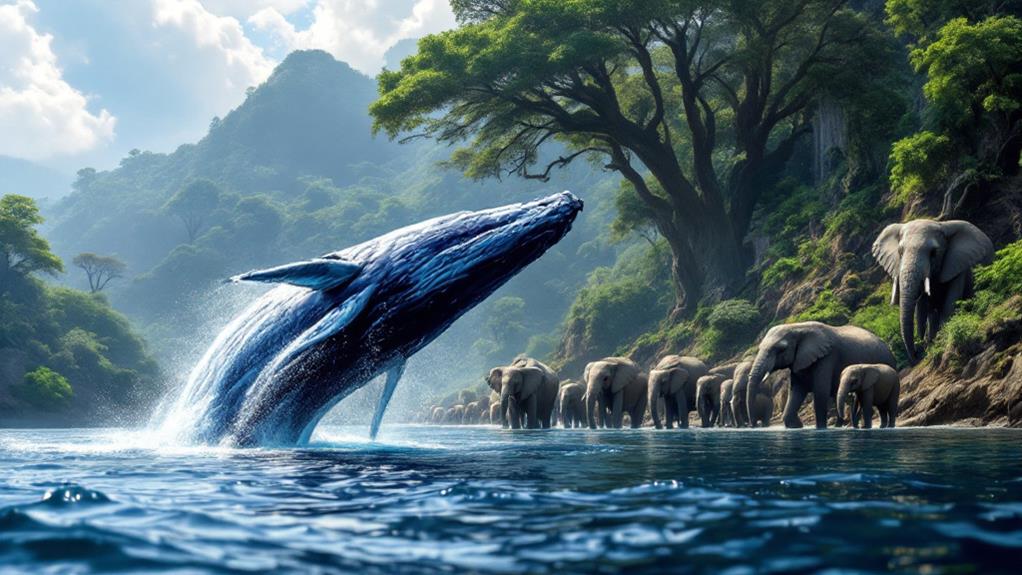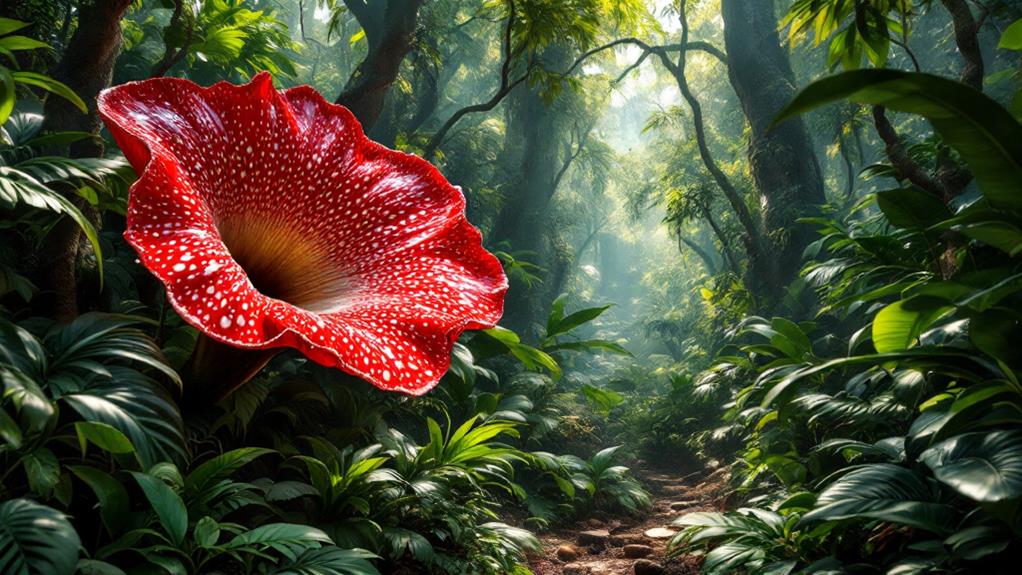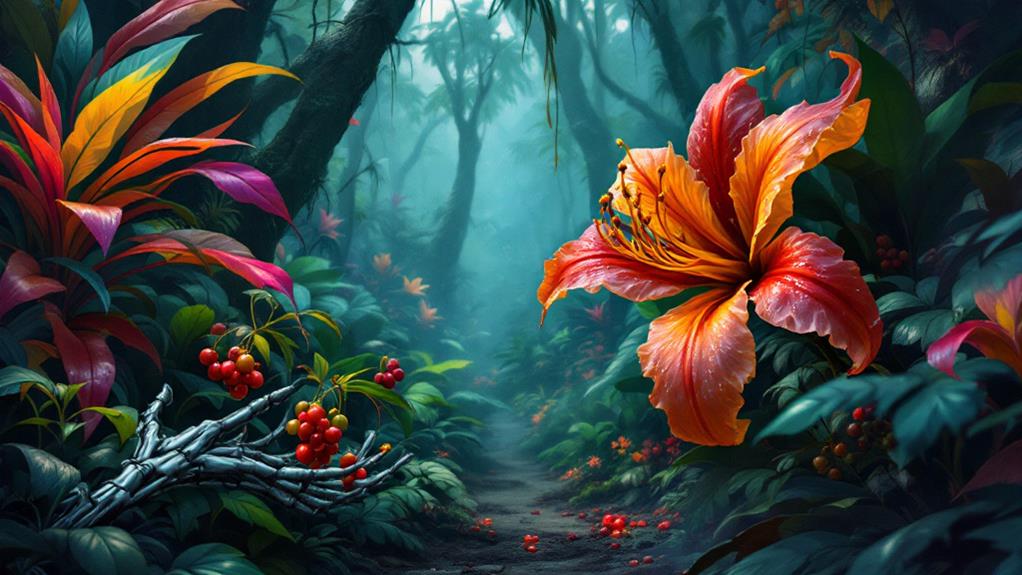Strange Places on Planet Earth: Mysterious and Unique Locations
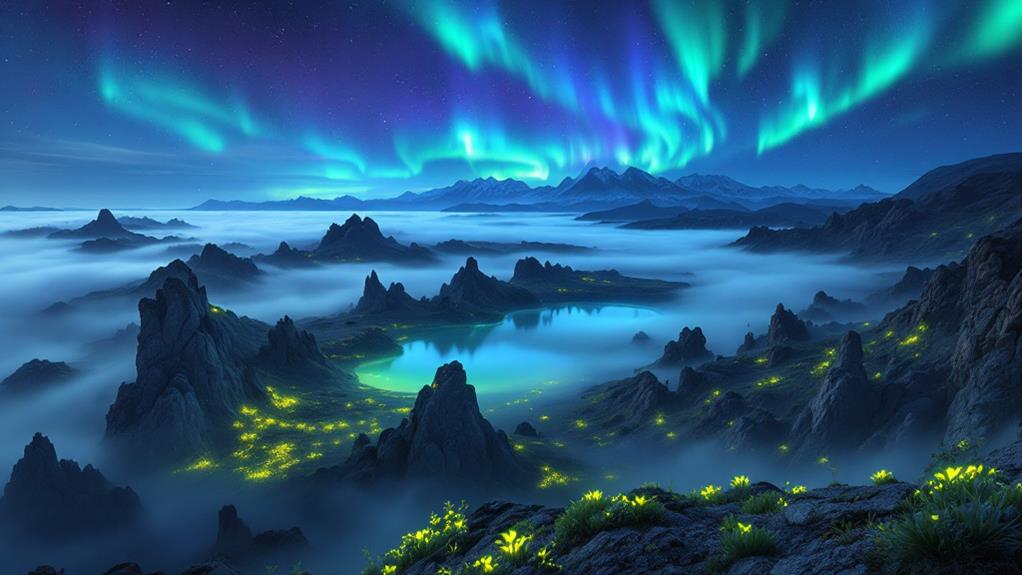
You're in for a treat with these peculiar and stunning places across the globe. Uncover Lake Natron in Tanzania, with its eerie crimson waters that support flamingos in seemingly inhospitable conditions. Visit Turkmenistan's Door to Hell, where a fiery gas crater burns unearthly orange. Marvel at New Zealand's Moeraki Boulders, perfectly spherical formations scattered across a beach. Witness the Sailing Stones of Death Valley glide mysteriously across the desert floor. Tread through the Catacombs of Paris, where history is eerily tangible in walls of bones. As you continue, prepare to be fascinated by these wonders and what they reveal.
Lake Natron, Tanzania
Lake Natron's eerie beauty captivates anyone who ventures near its shores. As you approach this Tanzanian marvel, the volcanic landscape unfolds before you, a stark contrast to the lush African plains. The lake lies in the East African Rift Valley, where tectonic activity gives rise to its unique geological features. Ash and lava from nearby volcanoes contribute to the area's surreal terrain, painting a picture of raw, untamed nature.
Walking along the lake's edge, you'll notice the expansive salt flats that stretch out like a shimmering white carpet. These flats are the result of high evaporation rates, leaving behind a thick crust of sodium carbonate and other minerals. The lake's highly alkaline waters, sometimes reaching a pH above 12, create an inhospitable environment for most life forms. Yet, flamingos thrive here, feasting on the algae that flourish in the caustic conditions.
The lake's vivid red hues, caused by salt-loving microorganisms, add to its otherworldly allure. Standing at Lake Natron, you can't help but marvel at nature's artistry, where harsh conditions and stark beauty coexist. It's a place that challenges your perception of life and survival.
The Door to Hell, Turkmenistan
As you leave behind the serene yet harsh beauty of Lake Natron, prepare yourself for another of Earth's enigmatic wonders: the Door to Hell in Turkmenistan. This fiery spectacle, officially known as the Darvaza gas crater, has captivated visitors with its eternal flame. Situated in the heart of the Karakum Desert, this fire crater burns ceaselessly, casting an eerie glow against the night sky.
The story of its creation is as fascinating as the sight itself. In 1971, Soviet geologists set out to investigate the region's rich natural gas reserves, a significant aspect of Turkmenistan geology. During their drilling operations, the ground beneath them collapsed, forming a massive crater. To prevent the release of poisonous gases, they ignited the crater, believing it would burn out in a few weeks. Over half a century later, the inferno still rages on.
Standing at the edge of the crater, you feel the immense heat radiating from its depths. The Door to Hell serves as a stark reminder of nature's unpredictability and man's unintended influence on the environment. It's a mesmerizing and humbling encounter, merging human ambition with the untamed forces of Earth.
Moeraki Boulders, New Zealand
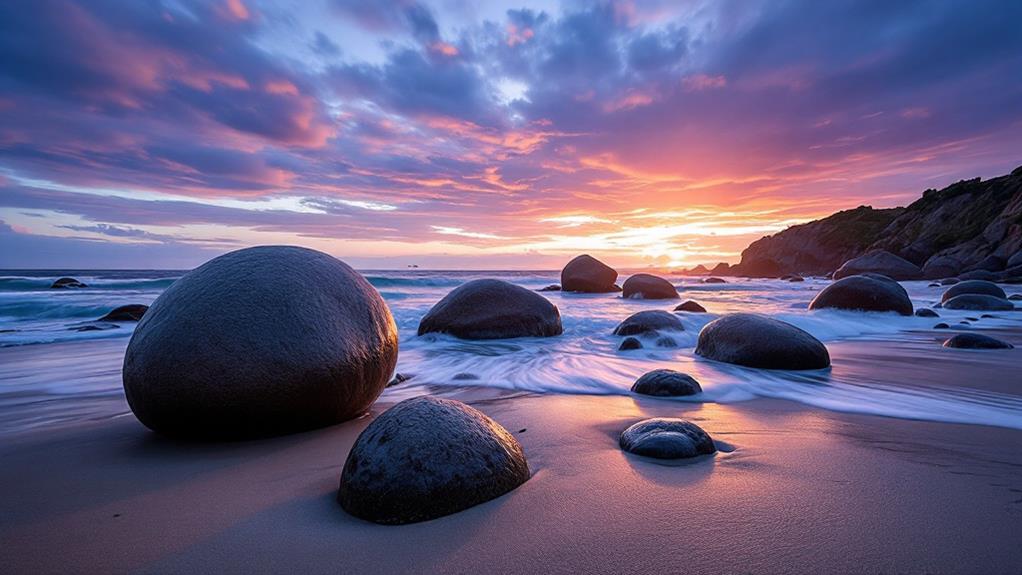
Venture to the windswept beaches of Koekohe Beach on New Zealand's Otago coast, and you'll encounter the mysterious Moeraki Boulders. These spherical marvels, scattered across the sands, captivate visitors with their sheer size and almost otherworldly appearance. The boulder formation is a geological phenomenon, drawing curious minds from around the globe.
As you investigate, you'll notice that these boulders aren't just any ordinary rocks. Formed over millions of years, they are concretions, which means they developed through the gradual accumulation of sediment and minerals. Each boulder can measure up to two meters in diameter, making them an impressive sight against the backdrop of the sea. Their smooth, round shapes are the result of erosion that reveals the hardened layers beneath.
The geological significance of the Moeraki Boulders extends beyond their striking appearance. They offer a glimpse into Earth's history, providing valuable insights into ancient marine sedimentary processes. As you walk among them, imagine the slow, relentless forces of nature that shaped these stones, and consider the mysteries they hold from the past. It's a humbling experience, one that connects you to the vastness of geological time and the incredible story of our planet.
Sailing Stones, Death Valley
Deep within the arid expanse of Death Valley lies an enigmatic natural wonder known as the Sailing Stones. These seemingly ordinary rocks have captured the curiosity of many due to their mysterious phenomena. Imagine standing in the vast Racetrack Playa, a dry lakebed where these stones, some weighing hundreds of pounds, appear to glide across the cracked surface, leaving long trails behind. You'd think someone must've moved them, but that's not the case.
For years, scientists and visitors alike scratched their heads, wondering how these stones travel without human or animal intervention. It wasn't until recently that researchers uncovered the secret behind this natural wonder. During rare winter rains, a thin layer of ice forms over the playa. As the sun rises and melts the ice, gentle winds push the stones slowly across the slick surface, creating those puzzling tracks. It's a perfect mix of conditions that makes this remarkable movement possible.
When you visit Death Valley, you'll witness initially the quiet majesty of these Sailing Stones. They stand as a reminder of nature's ability to surprise and amaze us with its intricate and mysterious phenomena.
The Catacombs, Paris
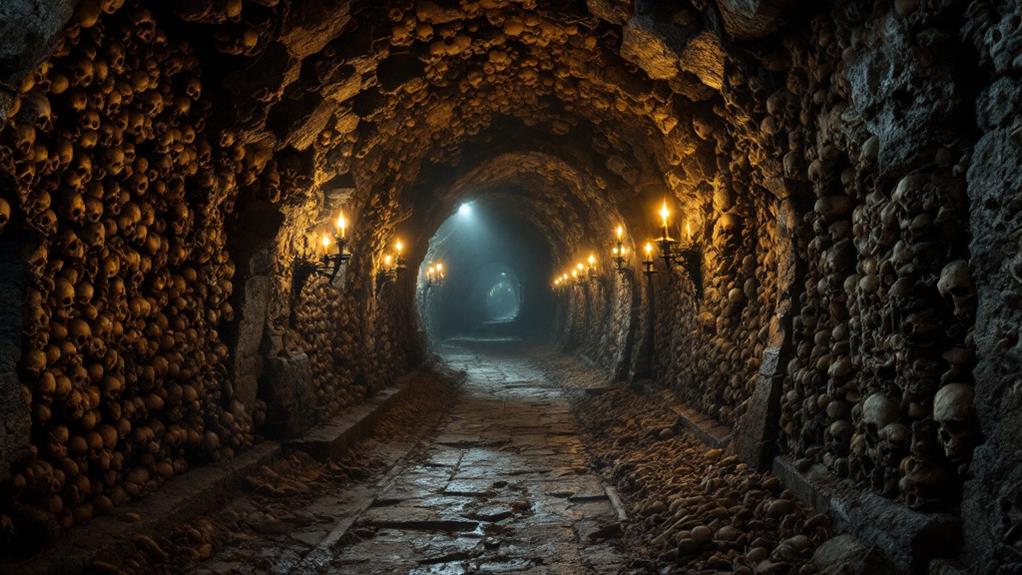
Though Paris is known for its romance and culture, beneath the lively streets lies a network of tunnels that tell a darker story—the Catacombs. As you venture into these underground tunnels, you step into a domain of eerie silence and historical significance. The Catacombs house the remains of over six million people, a chilling indication of Paris's past. These tunnels originally served as limestone quarries, but by the late 18th century, they became the final resting place for countless Parisians, moved from overcrowded cemeteries to address public health concerns.
Walking through the dimly lit passages, you can't help but feel the weight of history pressing in. The bones are carefully arranged, forming macabre walls and structures. Each corner of the Catacombs whispers stories of those who've long passed, offering a unique glimpse into the city's past. It's a stark contrast to the lively life above ground, yet it holds a compelling allure.
Visiting the Catacombs isn't for the faint-hearted, but it provides an unforgettable perspective on Paris's history. You'll leave with a profound appreciation for the city's complex layers, both above and below the surface.
Fly Geyser, Nevada
While the haunting corridors of the Paris Catacombs invite deep reflection, the lively spectacle of Fly Geyser in Nevada offers a different kind of wonder. Situated in the Black Rock Desert, this colorful geothermal feature is a feast for the eyes. You'll be captivated by the brilliant reds, greens, and yellows that splash across its surface, created by thermophilic algae thriving in the mineral-rich environment. Unlike anything you've seen before, Fly Geyser is a demonstration of nature's unpredictable beauty.
Fly Geyser wasn't always a natural wonder. In 1964, a drilling mishap while searching for geothermal energy transformed this location into the stunning site it is today. The geyser continuously spews hot water, creating terraces of travertine that have grown over time. As you stand before it, you'll feel the power of nature reshaping the landscape in real-time.
To visit Fly Geyser, you'll need to plan ahead. Access is limited, so obtaining permission is crucial. Once there, the experience is both surreal and serene. As you investigate, you'll understand why this hidden gem remains one of Nevada's most cherished geothermal features, offering a glimpse into Earth's dynamic processes.
Pamukkale, Turkey
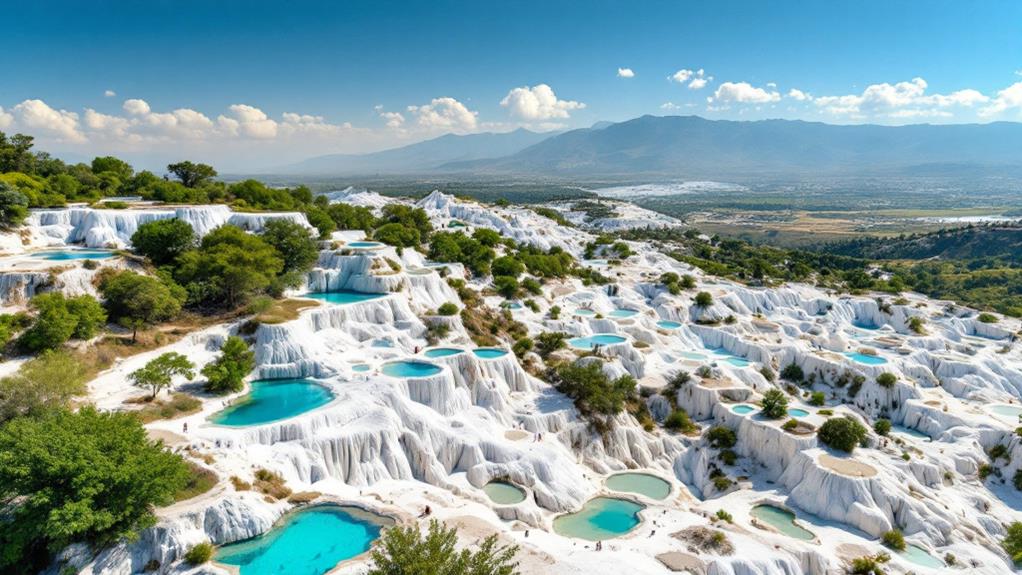
Pamukkale, Turkey, dazzles with its ethereal beauty and historical significance. As you approach this stunning natural wonder, you're greeted by a vision of gleaming white terraces cascading down a hillside. These terraces are formed by mineral-rich thermal pools, which have drawn visitors for centuries. The warm, soothing waters are not only a sight to behold but also offer a relaxing dip that promises rejuvenation.
When you're in Pamukkale, a visit to the ancient spa city of Hierapolis is a must. Founded in the 2nd century BC, Hierapolis thrived as a cultural hub due to its proximity to the thermal pools. You can wander through the impressive ruins, where history feels palpable. Imagine the ancient Romans who once soaked in these very thermal waters, seeking healing and relaxation.
The combination of natural beauty and historical intrigue makes Pamukkale a unique destination. You can experience the magic of walking where emperors and citizens of old once strolled, all while enjoying the therapeutic benefits of the thermal pools. Pamukkale invites you to connect with nature and history in a way that few places on Earth can offer.
The Island of Dolls, Mexico
After exploring the serene beauty of Pamukkale, shift your attention to the chilling allure of the Island of Dolls in Mexico. Situated within the Xochimilco canals, this island captivates visitors with its macabre charm. As you approach, countless dolls hang eerily from trees, their weathered bodies and vacant eyes creating a haunting spectacle.
The origin of this unsettling display lies in the island's doll history and the legends that surround it. According to local lore, a man named Don Julián Santana Barrera inhabited the island. He found a young girl's body in the canal and soon after, discovered a doll floating nearby, believed to be hers. In a gesture of respect, he hung the doll on a tree. However, he was plagued by the girl's spirit, compelling him to hang more dolls to appease her restless soul. Over fifty years, Don Julián continued collecting and displaying dolls, transforming the island into the eerie site it is today.
Visiting the Island of Dolls offers a glimpse into this fascinating blend of tragedy and tribute. You'll find yourself drawn into the island's legends, feeling an otherworldly presence with each step.
Blood Falls, Antarctica
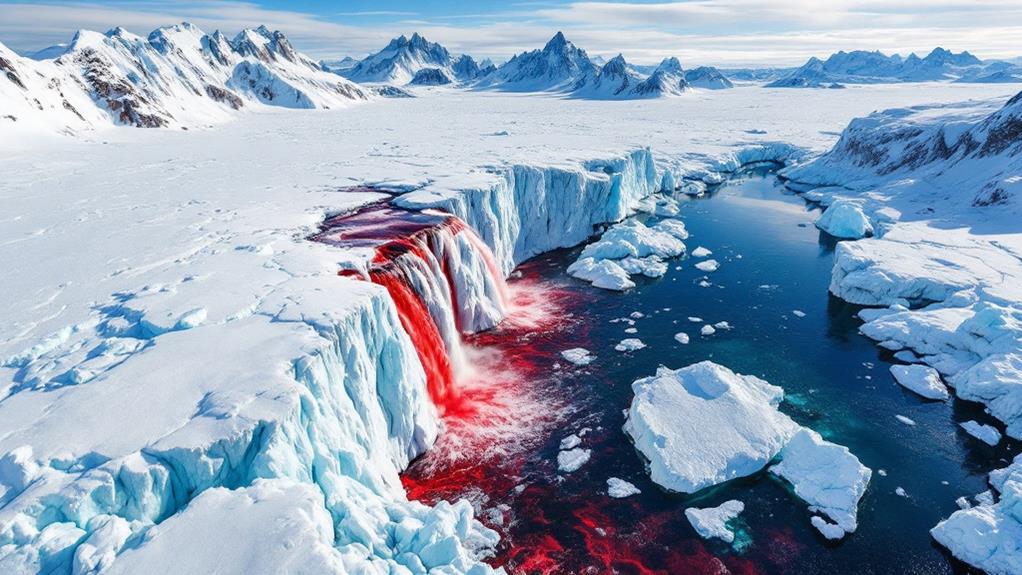
When you venture to the icy expanse of Antarctica, the stark beauty of Blood Falls immediately grabs your attention. This enchanting natural phenomenon, where iron-rich water flows from the tongue of Taylor Glacier, stands out against the white backdrop of ice and snow. The lively red hue of the water is a result of oxidized iron, offering a glimpse into the unique geology of the region. Blood Falls is a symbol of the complex Antarctic ecosystem, a place where life persists in the most extreme conditions.
Scientific research at Blood Falls provides valuable insights into the climate impact on glacial formations. The subglacial pool of salty, iron-rich water, isolated for millennia, acts as a natural laboratory for scientists. Studying it helps you understand how life can thrive in seemingly inhospitable environments and informs predictions about climate changes.
Blood Falls holds historical significance, initially uncovered by geologist Griffith Taylor in 1911. Today, it remains a site of remote exploration, challenging researchers with its harsh conditions and offering profound revelations. As you observe this mysterious location, you can't help but marvel at Earth's hidden wonders and the secrets still waiting to be unveiled.
